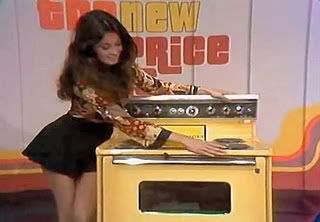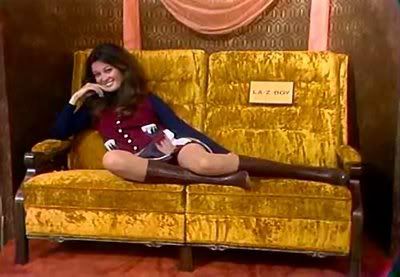Poll
| No votes (0%) | |||
 | 1 vote (11.11%) | ||
 | 8 votes (88.88%) |
9 members have voted
OLD RULES:
Five different numbers in a sack along with three "strikes." Pick a numbner and you can guess its place in the price. Guess right and that number lights up and the number is removed. Pick a stgrike and an "X" lights up. Three strikes before getting all the numbers and you lose, get the numbers first and you win.
NEW RULES:
Five numbers are places and ONE strike chip. If you draw the strike chip the "X" still lights up but the strike is returned to the sack.
Mathematically, what are the odds of winning either way? This one gets a little tricky to calculate since there is some judgment involved, such as the first number being almost always a 1 or 2 and easy to judge, along with the second then being easier to judge high or low based on the first.
And I like Holly best!
Who was the read-head with the bangs?
Janice Pennington
Dian Parkinson
Holly Halstrom

It's tough, but I think I was always a Holly fan, too. Not because of the looks, but the stage presence. She's the one who was sometimes tripping, or knocking something over.
Quote: AZDuffman
Five different numbers in a sack along with three "strikes." Pick a numbner and you can guess its place in the price. Guess right and that number lights up and the number is removed. Pick a stgrike and an "X" lights up. Three strikes before getting all the numbers and you lose, get the numbers first and you win.
What happens if you draw a number but guess wrong? Do you lose then, or return the number to the sack and keep playing?
Quote: weaselmanWhat happens if you draw a number but guess wrong? Do you lose then, or return the number to the sack and keep playing?
The number goes back in the bag. As I recall, the game ended when the contestant wither won the car or drew all three strikes.
There was a game that used dice to determine the price of a car. It was more complicated.
I am sure this has been done, and odds are available somewhere. I find it more satisfying to do it myself.
You are speaking of "Dice Game". Players are given the first digit of a 5-digit price. The other 4 digits are "guessed" by rolling a 6-sided die. If the roll is correct, the number lights up. If not, the player guesses if that digit is higher or lower. All numbers in the price are 1, 2, 3, 4, 5 or 6.Quote: NareedThere was a game that used dice to determine the price of a car. It was more complicated.
Not only does a number light up when correctly rolled, but just as good is rolling a 1 or 6: That digit must be higher or lower, respectively. There has been one case in the 38+ year history that someone rolled all digits correctly. I believe there are a tiny handful of cases where all digits are either rolled correctly or a 1 or 6.
In the meantime, back to work on on 3 Strikes...
Quote: AZDuffmanThanks for adding the pics, how could I have not done so? Anyways, I agree on the stage presence think. Holly was the only one who if I was actually with her wouldn't leave for someone better looking who made more money. How she was forced to live in her car for some time is beyond me--I was always suprised none of the models ever did much outside work.
Man, if you read her wiki entry, those women had to put up with a lot. She won a multi-million dollar settlement against Barker (they all did), and Holly actually could have won more, but took a smaller amount that didn't carry a gag order so that she could tell her side of the story (Barker would have had no gag order in any case). She seems like a strong woman.
3 Strikes in bag:
206,799 wins (20.6%, about 1 in 5)
1 Strike in bag:
442,482 wins (44.2%, about 4 in 9)
Keep in mind this is all pending my simulations ran correctly, though I did test them fairly well. I could not find any other pages that gave the odds of winning this game, perhaps because of the multi-branched probabilities.
Also:
Holly, hands down.
Overall what's the probability of winning in The Price is Right?
It's a lot more complicated than it sounds, as a contestant has anywhere from one to four opportunities to win. There's the contestan's row part, the game on stage, the big wheel and the showcase. As I understand the mechanics of the game, in the row and wheel part you only win a chance to play some other game where you can win prizes. But you can also win cash if you guess the exact prize and, in the wheel, if you hit $1.00 in either one or two spins.
Further while chance plays a large factor, skill also matters. In the putting game, I'd bet more on Tiger Woods from the farthest position than on John Doe from the closest, for example.
And of course the show makes money from sponsosr, not from players. ON TV that is. I suppose the show at Bally's makes money from ticket sales.
There are 325 seats in the audience, though they may give 400 tickets out.
There are 9 contestants picked each show. The first 4 have 6 chances to get on stage, then 9th has only 1. The 9th also must bid first, putting them at a disadvantage.
The bidding starts with the person in the leftmost position (as watching from home), or with the person filling a vacancy from a previous bid-winner. The last person to bid has the greatest chance of winning, as they may "One Dollar" someone for the best chance to win; This means they may bid $1 (they believe everyone else has overbid), or they may bid $1 above any bid, effectively locking their opponent out, and giving the largest range of win possibilities.
Winners of a One-Bid (Contestant's Row) win the prize outright. The three contestants remaining after the 6th One-Bid receive consolation prizes. (Is that considered "winning"?)
Because the Item Up For Bids and the Pricing Game the contestant plays is in effect random, it is not possible to effectively gauge which player has the advantage. The first game has a tendency to have a large prize, but may be difficult to win. The fourth game played is usually a quick game, and may only have a 50/50 decision.
Pricing Games vary in difficulty. They may be 50/50, up to 1/720 or worse for random guesses. Prizes tend to be bigger for harder-to-win games, but this is not necessarily the case. One game, Temptation, awards players thousands in free prizes for doing nothing, but only if they do not attempt to win the car being offered.
The Big Wheel (Showcase Showdown) is a near-even proposition. The contestant winning the least (total of One-Bid & Pricing Game) goes first, and the top winner goes last. According to The Wizard, the average chances of winning when going first is 30.82%, going second is 32.96%, and third is 36.22%. There is slightly greater than 5% chance of getting $1.00, which awards $1,000 and a bonus spin. There is a 15% chance of winning $10,000 or more in the bonus spin.
The Showcases are not easy to quantify. There is a slight risk that both players lose (Double Overbid), but most times one player wins. The Top Winner (greatest amount won from One-Bid, Pricing Game, Bonus Spin $), may bid first, or pass the first Showcase, and bid second. Bidding second has an advantage, though people rarely seem to take it.
Whew!
Quote: Dween
1 Strike in bag:
442,482 wins (44.2%, about 4 in 9)
Hmmm ... the answer I am getting is significantly lower for some reason ...
Basically, if there are n numbers left to guess, the probability of getting a strike is 1/(n+1) and the probability of getting the right guess is n/(n+1)*1/n = 1/(n+1).
So, the probability of getting a strike is the same as to not get a strike and guess the right place. Ignoring incorrect guesses (if the ball goes back, they don't affect the outcome anyway), the conditional probabilities of strike and right guess are 0.5/0.5.
So this question is then equivalent to the odds of throwing 5 heads before 3 tails with a fair coin. If I am not mistaken, the answer is something like this:
(1/2)^5 + (1/2)^6*combin(5,1) + (1/2)^7*combin(6,2) = 0.2265625 = 29/128
It also seems that the "1 or 2 first" optimization does not help under these rules, since the probability of pulling the "good" number (1 or two) out of the sack - 1/(n+1) - is the same as the probability of just pulling any number and guessing its place correctly.
One reason I can think of for the odds being somewhat higher in real life is that the guessing process is finite - if you pull a number and guess wrong, the probability of the right guess next time goes slightly up (because if you pull it again, you only need to choose from n-1 places), while in my formula it stays constant. Does your simulation use this prior info for guessing?
Even if it does, it seems unlikely to account for almost doubling the result ... something else must be different.
Quote: weaselmanOne reason I can think of for the odds being somewhat higher in real life is that the guessing process is finite - if you pull a number and guess wrong, the probability of the right guess next time goes slightly up (because if you pull it again, you only need to choose from n-1 places), while in my formula it stays constant. Does your simulation use this prior info for guessing?
Even if it does, it seems unlikely to account for almost doubling the result ... something else must be different.
Well, let's look at it this way. My simulation uses a logic grid, 5x5. It uses the assumption that you know the first digit. We'll also for the sake of argument say the price of the car is $12,345.
| # | 1 | 2 | 3 | 4 | 5 |
|---|---|---|---|---|---|
| 1st | K | x | x | x | x |
| 2nd | x | ||||
| 3rd | x | ||||
| 4th | x | ||||
| 5th | x |
As numbers are picked, and incorrect positions are determined, more "x" symbols will be placed in the grid. As numbers are correctly placed, the rest of the row and column are marked out, as in the above grid with 1/1st. It makes the possibility of picking future numbers much more likely.
I think by saying the conditional probabilities of strike vs. right guess are 0.5/0.5, it's the ignoring wrong guesses is where your numbers may be going wrong.
This next bit may look confusing, but let's give it a shot:
Let's say there are two numbers and two positions. Odds of strike = 1/3. Odds of picking number, getting it right = 1/3. Odds of picking number, getting it wrong = 1/3 --> Then, odds of strike = 1/3, odds of picking number and getting it right = 2/3.
Strike = 1/3 + (1/3*1/3), Right Guess = 1/3 + (1/3*2/3)
Strike = 1/3 + 1/9 = 4/9, Right Guess, 1/3+2/9 = 5/9.
0.44/0.55, not 0.5/0.5




